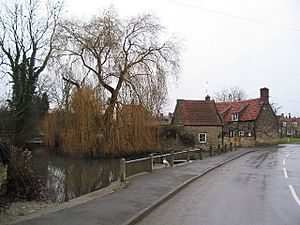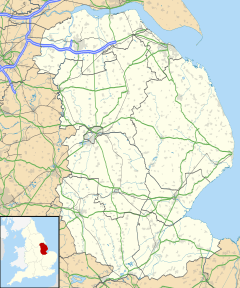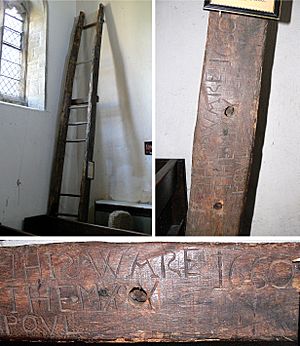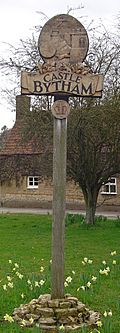Castle Bytham facts for kids
Quick facts for kids Castle Bytham |
|
|---|---|
 Castle Bytham village pond |
|
| Population | 768 (2011 census) |
| OS grid reference | SK989185 |
| • London | 90 mi (140 km) S |
| Civil parish |
|
| District |
|
| Shire county | |
| Region | |
| Country | England |
| Sovereign state | United Kingdom |
| Post town | GRANTHAM |
| Postcode district | NG33 |
| Dialling code | 01780 |
| Police | Lincolnshire |
| Fire | Lincolnshire |
| Ambulance | East Midlands |
| EU Parliament | East Midlands |
| UK Parliament |
|
Castle Bytham is a village in Lincolnshire, England. It has about 300 houses and is located in an area called South Kesteven. The village is about 9 miles (14 km) north of Stamford and 9 miles (14 km) west of Bourne. In 2011, 768 people lived here.
Long ago, Castle Bytham was a busy place for farmers. Today, many people who live here travel to other towns for work. However, some farming families still live in the village.
Contents
History of Castle Bytham
The name 'Bytham' was first written down in 1067. It comes from an old English word meaning 'valley bottom' or 'broad valley'. In 1086, a big survey called the Domesday survey called the village West Bytham. This was before the castle was built. People later named the river that flows through the village the Tham or Am.
During World War II, Morkery Wood, near the village, was used to store bombs for nearby airfields. On November 19, 1942, a Handley Page Halifax plane crashed there. It was returning from a bombing mission in Italy when it was hit by enemy fire.
Castle Bytham's Famous Castle
Overlooking the village is an old Norman castle mound. This castle was built in the 11th century. Before the Normans arrived, a Saxon earl named Morcar owned the land.
After the Normans took over England, William the Conqueror gave the castle to his half-brother, Odo. Later, other powerful families owned it. In 1221, during a time of fighting called the First Barons' War, King Henry III captured the castle. He then gave it back to its owner, William de Coleville.
The castle was burned down in the 1400s during the Wars of the Roses. By the 1500s, only large walls of the castle remained.
Geography of Castle Bytham
The closest town to Castle Bytham is Stamford. Even though the village is in the Grantham postal area, it sits where three different postcode areas meet: NG (Grantham), LE (Rutland), and PE (Stamford).
The village is very close to the border of Rutland. The area around the village, called the civil parish, stretches far to the north-west. This includes Red Barn Quarry. It also goes west to include all of Morkery Wood, which was named after the Saxon earl Morcar.
To the south, the parish includes Pillowsyke Holt, a piece of woodland. To the east, the parish includes Lawn Wood. This 30-acre wood has been a nature reserve since 1995. It is connected to two meadows that were given to the Lincolnshire Wildlife Trust in 1993. These meadows are great for seeing buttercups and yellow rattle flowers. They are managed to help butterflies like the ringlet and meadow brown. The wood has many oak and ash trees. You can also find field maple and the rare wild service tree. Woodland flowers like wood anemone and early purple orchid grow here too. You might even spot fallow deer and red deer in the reserve.
Businesses in Castle Bytham
- The Clever Coop Company
- Steel Landscaping Co.
- Waggy Tailz
- The Rosewell Centre
Surrounding Area of Castle Bytham
About 1 mile (1.6 km) east of Castle Bytham is Little Bytham. These two villages used to be called West and East Bytham.
To the west, across the A1 road, is South Witham. The Lincolnshire Wildlife Trust looks after an important wildlife area called Tortoiseshell Wood near the village. Some road sides are also protected for wildlife by Lincolnshire County Council.
West of the village, towards Clipsham, there is a Yew Tree Avenue. The Forestry Commission looks after these trees, which are cut into large topiary shapes.
Community Life in Castle Bytham
The church in Castle Bytham is part of a group of local churches. The community in Castle Bytham holds several events each year in the village hall.
Every year, Castle Bytham has a midsummer fair and street market. This fair has many stalls, a duck race, a dog show, a funfair, and games for children. There are also places to get food and drinks. The fair has raised over £40,000 for local causes. These include a Christmas lunch for older people and a party for children. The money also helps improve things in the village. People are working to make the village recreation ground better for young people.
There is a village shop on Pinfold Road. The Castle Bytham Post Office closed in 2008. It used to serve many nearby villages. Now, a mobile post office service visits the village.
The village has two pubs: the Fox & Hounds and the Castle Inn. Another old pub, the New Inn, became houses in the 1960s.
Former Railway Station
Castle Bytham once had a railway station. You can still see parts of it today. This station was unusual because it had only one platform in a deep cutting (a dug-out area) through the village. The railway company did not plan to build a station here at first. But local people asked for it, and so it was added. The station and a goods yard (where goods were loaded and unloaded) stayed open until the railway line closed in 1959. West of the village, the old railway line now forms a road that goes under the A1 road.
Places of Worship
The village church, St James, was started in the 12th century and fixed up in 1900. It has something special: a ladder that was once used in the church tower. It has a carving that says "THIS WARE THE MAY POVL 1660". This shows that people in the village held May celebrations to mark the return of King Charles II to the throne in 1660.
There used to be a Methodist chapel on High Street. It is now a private house. When it closed in 1972, a preacher from Stamford still came to the village for a few years. Services were then held in the parish church.








